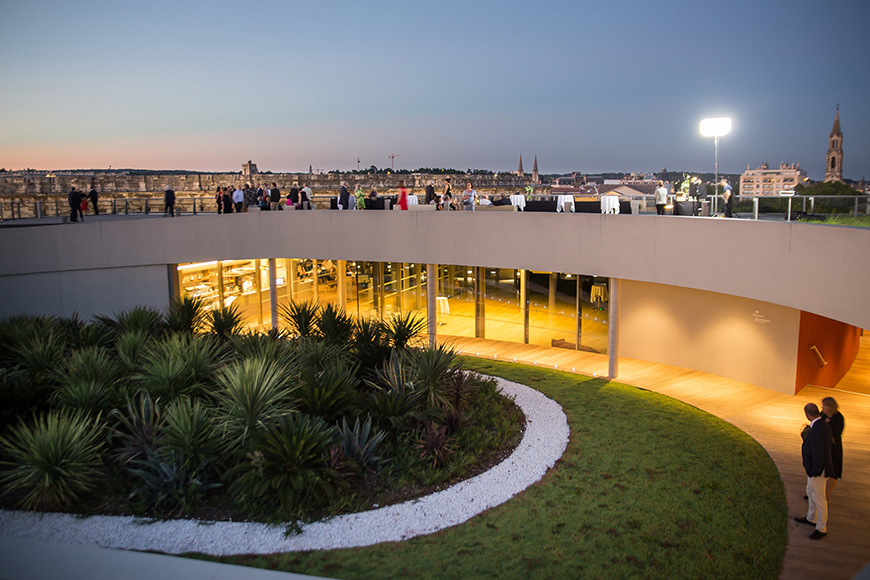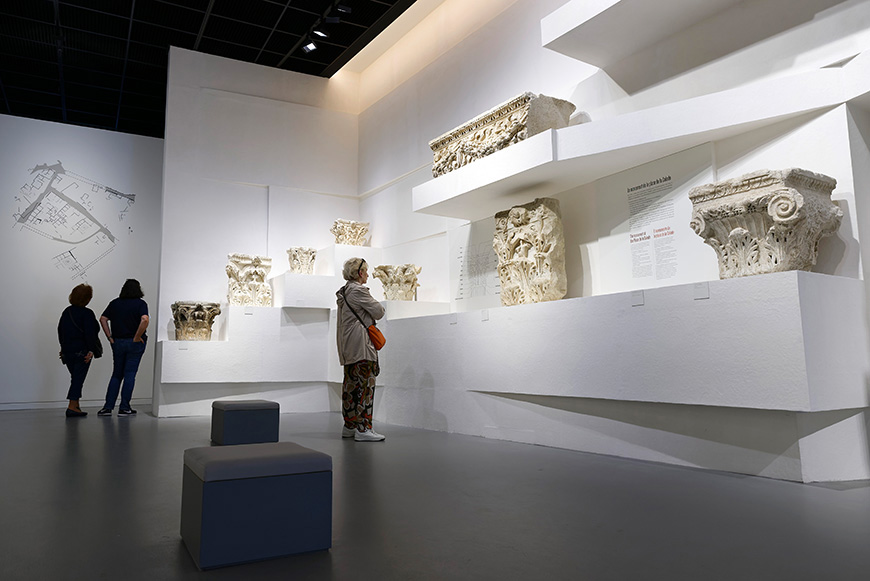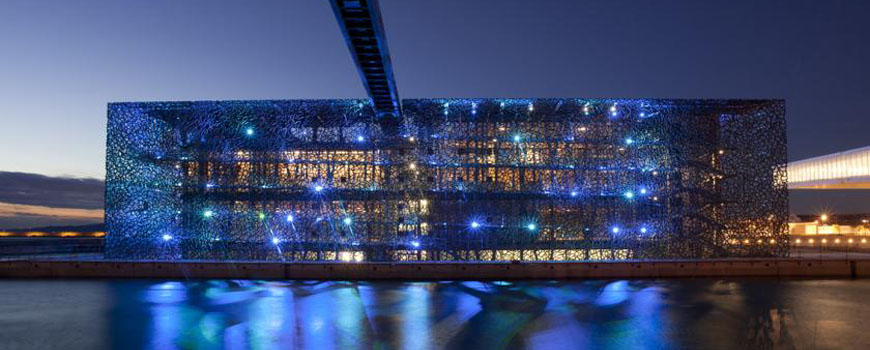Musée de la Romanité, Nîmes
Occitanie, France
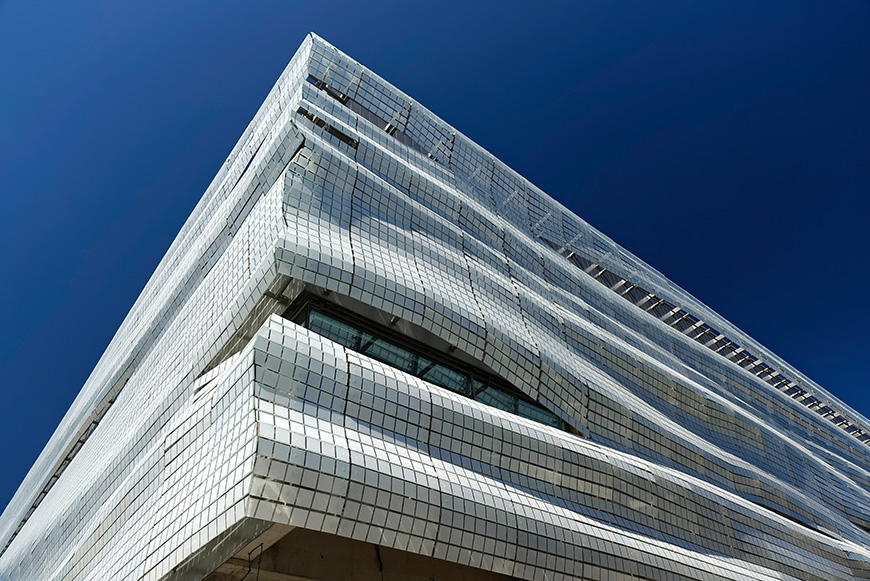
The Musée de la Romanité is an archaeological museum in Nîmes, a mid-sized city in the region Occitanie, in southern France, renowned for its exceptionally preserved Roman monuments. Clad in thousands of translucent glass tiles, the museum’s distinctive building was designed by French-Brazilian architect Elizabeth de Portzamparc.
Above, a close-up view of the facade of the Musée de la Romanité in Nîmes, designed by Elizabeth de Portzamparc; © Stéphane Ramillon – Ville de Nîmes.
History
Opened in June 2018, the museum is adjacent to the famous Arena of Nîmes, an imposing Roman amphitheater built in the 1st century CE and one of the world’s best-preserved examples of Roman architecture.
The idea to create a new museum to present the city’s archaeological collections was devised by the Mayor of Nimes, Jean-Paul Fournier, in the early 2000s.
Founded by the Romans in the 1st century BC as Colonia Nemausus, Nîmes quickly archived great relevance during the Roman Empire for its strategic position halfway along the Via Domitia road that connected Italy and Spain.
The city still retains some of the most impressive Roman buildings in Europe, including the Maison Carrée, the Temple of Diana, a part of the ancient walls with two gates, the Pont du Gard Roman aqueduct, and the Amphitheater.
The museum with the Roman Arena in the background; photo © Stéphane Ramillon – Ville de Nîmes.
The architecture of the Roman Museum of Nîmes
The project by Elizabeth de Portzamparc is the winner of an architectural design competition, organized in 2013, in which it was selected previously as one of the three finalist entries, together with those by Rudy Ricciotti and Richard Meier.
With a gross floor area of 9,100 square meters / 98,000 square feet, the building designed by de Portzamparc consists of two volumes, the largest is a four-story box with a perfectly square plan which houses the museum’s exhibition halls and visitors’ facilities, while the smaller one is a rectangular construction that contains educational rooms and administration offices.
At street level, the building is crossed by a covered passageway, connecting the square of the Nîmes Arena with an archaeological garden behind the museum, onto which the museum’s 17-meter-high glassed lobby opens.
The lobby is dominated by a large double-spiral staircase, inspired by the one designed by Leonardo da Vinci for the Chambord Castle, and by the remains of the monumental pediment of the ancient Sanctuary of La Fontaine nearby.
Together with the lobby, the ground floor houses four exhibition rooms and various visitor facilities – including a bookshop and a cafe – while the upper floors accommodate several permanent exhibition galleries; finally, the museum is topped by a roof garden encircling a central elliptical patio. The entire building is wrapped in an undulated skin composed of 7,000 translucent glass tiles.
An exterior view of the museum; © Stéphane Ramillon – Ville de Nîmes.
The Musèe de la Romanité is located on the border of the historical center of Nîmes, a city whose Roman heritage origins date back to the 1st century CE when it was founded with the name of “Colonia Nemausus”; photo © Philippe Roy.
The roof garden; © Olivier Arquès.
Collection and permanent exhibition
The permanent exhibition of the Musée de la Romanité covers some 25 centuries of the history of Nîmes, from the 7th century BC to the present. The exhibition is divided into 4 chronological sections dedicated to the Pre-Roman Period (7th-century BC-1st century BC), the Roman period (1st century BC – 3d century AD), the Middle Ages (10th-15th century), and the Legacy of Roman Antiquity.
Overall, the permanent exhibition features 65 interactive installations, full-scale reconstructions, models of ancient monuments, and some 5,000 artifacts – including sculptures, architectural decorations, mosaics, inscriptions, pottery, and religious and everyday objects – from the museum’s 25,000-piece collection.
The Musée de la Romanité also includes a 3,500-square-meter / 37,700-square-foot garden with archaeological remains and three botanical gardens, each featuring plants reminiscent of one of the historical periods presented in the museum’s permanent exhibition.
Fully accessible to physically-impaired people, the museum’s building also contains an 182-seat auditorium, a book and gift shop, a cafe, and a panoramic restaurant overseen by Michelin-starred chef Franck Putelat.
Two views of the museum’s permanent exhibition galleries; photos © Stéphane Ramillon – Ville de Nîmes.
Another view of the permanent exhibition; © Philippe Roy.
The collection of 19th-century models of Roman monuments on display in the permanent exhibition; © Stéphane Ramillon – Ville de Nîmes.
The garden of the Musée de la Romanité features archaeological remains as well as plants that were chosen according to the historical periods presented in the museum’s exhibition; photo © Stéphane Ramillon – Ville de Nîmes.
The museum at night; © Stéphane Ramillon – Ville de Nîmes.
All images are courtesy of Musèe de la Romanitè.
How our readers rate this museum (you can vote)
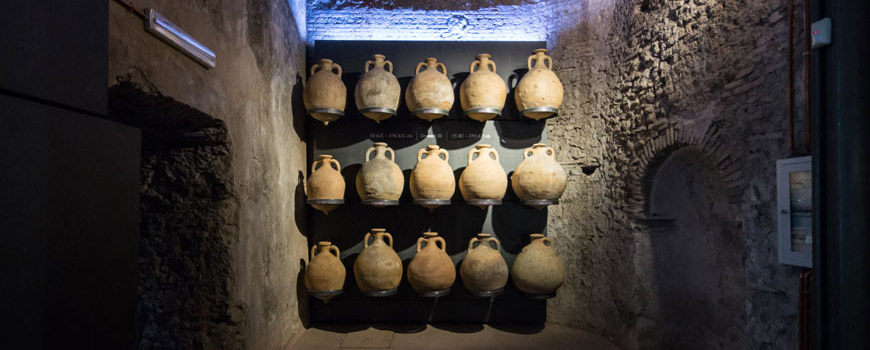
Museums of Archaeology and Archaeological Sites around the World
copyright Inexhibit 2024 - ISSN: 2283-5474




